The last voices of World War II: Veterans speak of duty and loss
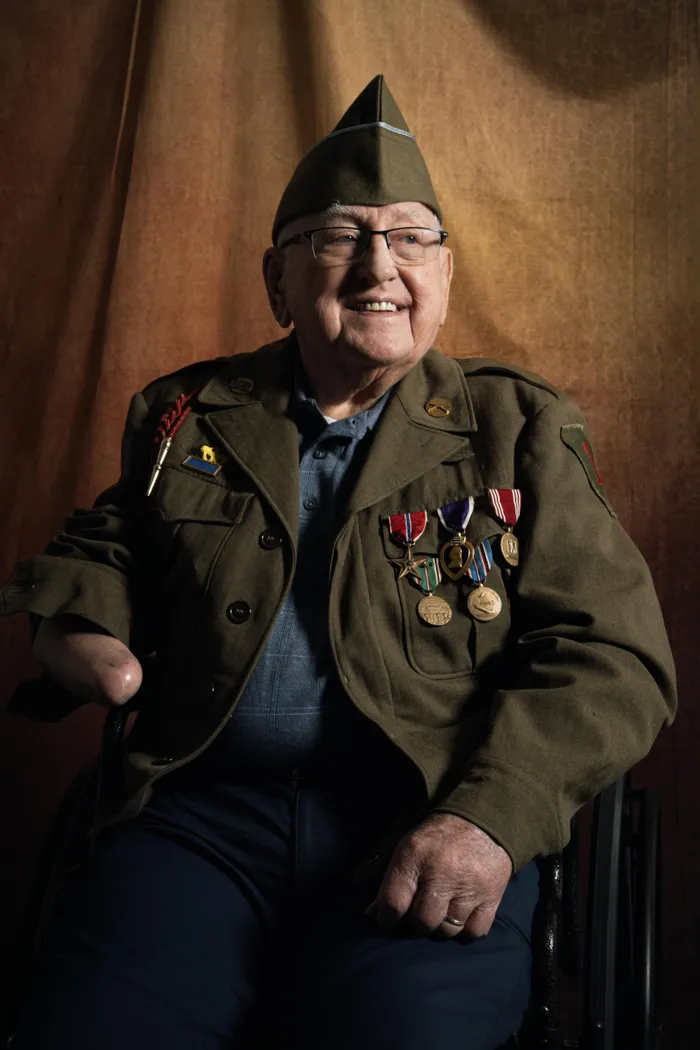
Russell Sattazahn, 99, lost his right hand in March 1945. “I was over there. I saw the heroes,” he told an audience, choking back tears. “I came home.”
Image: Maxine Wallace/The Washington Post
Joe Heim
World War II was nearing its end in March 1945 when Russell Sattazahn found himself taking cover from enemy fire with other GIs in the basement of a German house. At first they felt protected, but the onslaught was unrelenting. An artillery shell ripped through the brick, mortar and wood. Sattazahn, who had fought with the Army’s 1st Infantry Division a couple of months earlier in the bloody Battle of the Bulge, looked down and saw that his right hand had been blown off. His first thought, he remembers, was, “I’m never going to play baseball again.”
He was 18.
Now 99, Sattazahn told that story at the American Veterans Center’s annual conference this past weekend at the Omni Shoreham Hotel in Washington. There he joined veterans of America’s wars, including 40 World War II veterans, to share their experiences, remember the battles they fought and think again of the friendships that survived - and the ones war ended in an instant.
Some had told their stories before, but others were sharing them publicly for the first time.
Sattazahn, who lives in Schaefferstown, Pennsylvania, said people didn’t want to hear stories about the war when he first got back to the States. He also worried that people might think he was bragging about his experience. So he stayed quiet. At the conference he thanked the audience, which included veterans of other wars, ROTC students and members of the service academies. But he asked them not to call him a hero.
“I was over there. I saw the heroes,” he said, choking back tears. “I came home.”
For the American World War II veterans, all in their late 90s or early 100s, the event marked what will be one of the last times they gather to publicly relay what they endured and how it shaped them. And, perhaps, to offer lessons that a polarized America today might absorb from their sacrifice to fight and defeat fascism.
The veterans will be honored as part of the program “American Valor: A Salute To Our Heroes,” which will be broadcast on various channels beginning on Veterans Day. About 16.4 million Americans served in the Armed Forces in World War II. In 2025, there are approximately 45,000 who are still alive according to the National WWII Museum. Here are some of their stories.
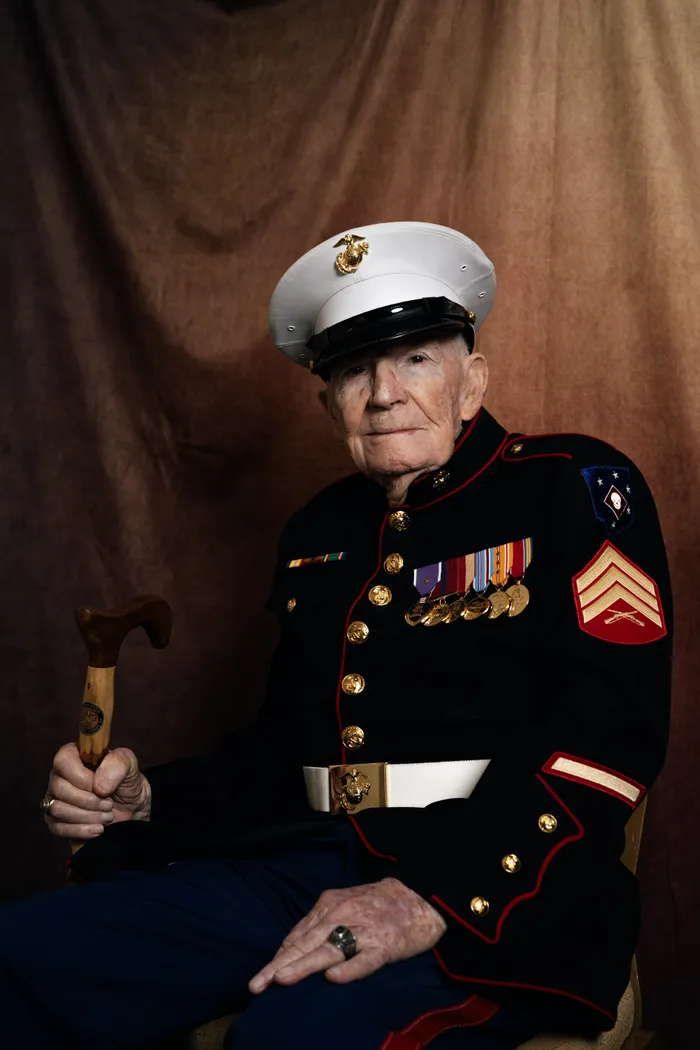
Frank Wright, 100, was a member of the famed Marine Raiders. Memories of his service in the Pacific still jolt him awake sometimes.
Image: Maxine Wallace/The Washington Post
Frank Wright, 100, Marines
The nightmares about what Frank Wright saw and did in World War II occasionally jolt him from his sleep. Now 100, Wright was 16 when he employed some creative paperwork to sign up with the Marine Raiders, an elite Special Operations force, in 1942. Over the next three years he would take part in some of the war’s most brutal battles. He was bayoneted by an enemy soldier in Guam and hit by machine gun fire at the Battle of Iwo Jima.
Despite the injury he suffered in Guam, Wright returned to the fight. “The unit was my home,” he said during a conference panel. “The boys were my kids. I was the squad leader and I had to take care of them.”
As he walked through the conference rooms, resplendent in his dress blues, Wright was stopped every few feet by people asking to take their photo with him. He said he was grateful for the attention and the opportunity to tell his story. But for Wright, who lives near Stockton, California, the war that ended 80 years ago is not history. The nightmares are still with him.

The Army was segregated during when Arlester Brown was drafted at 18 and sent for training with the 599th Quartermaster Laundry Company. He was hit by shrapnel in January 1945.
Image: Maxine Wallace/The Washington Post
Arlester Brown, 101, Army
The Army was still segregated during World War II when Louisiana native Arlester Brown was drafted at 18 and sent for training with the 599th Quartermaster Laundry Company. Soon he was in England as troops prepared for the D-Day invasion. Brown’s company followed the front line in Normandy and St. Lo, France, and then the Netherlands and Rhineland in Germany.
In January 1945, Brown said he remembers hearing a whirring noise in the air approaching his camp and then an explosion. A German V-1 flying bomb, known as a “buzz bomb,” detonated nearby. “After the explosion, the shrapnel just goes everywhere and I got a piece in my face,” Brown said Saturday. He was evacuated to England and then back to the States.
When he returned from the war, he found it difficult to obtain veterans benefits. He didn’t know he was eligible for the GI Bill and learned only by chance that his education costs would be covered by the country he served. Brown earned a bachelor’s degree at Grambling College (now Grambling State University), where he also played football. He would later add two master’s degrees and a doctorate in divinity. Last year, Brown returned to France where President Emmanuel Macron awarded him the Legion of Honour, France’s highest decoration, during a ceremony at Omaha Beach marking the 80th anniversary of the D-Day Allied landings in Normandy.
Brown lives at the Armed Forces Retirement Home, also known as the Soldiers’ Home, in Washington, D.C. When Macron visited Washington in February, he invited Brown to a reception at the French Embassy and thanked him again for his role in winning freedom for France
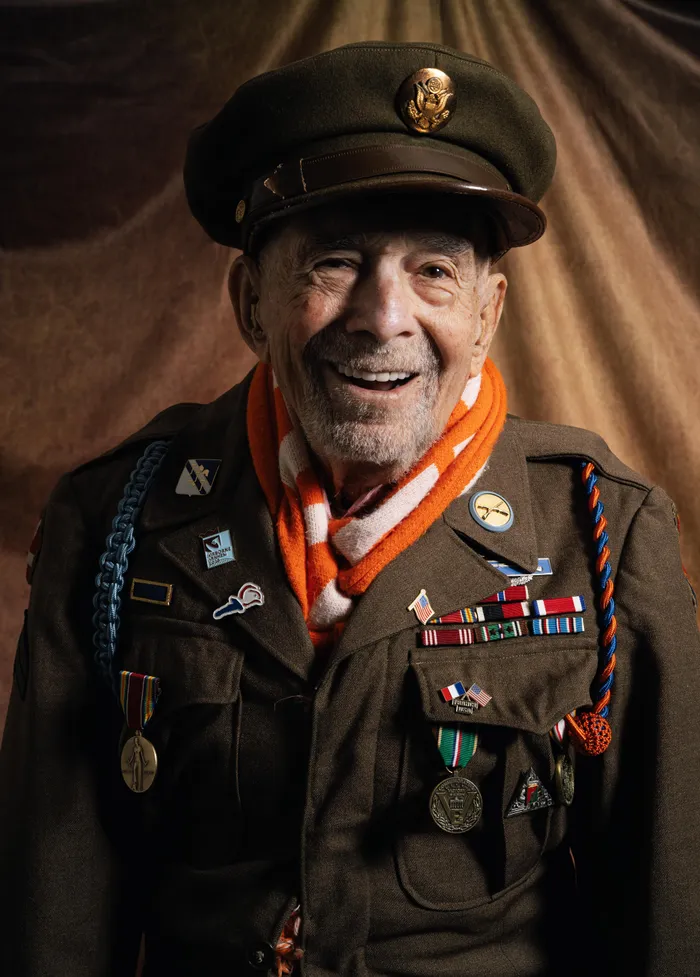
As a member of the 84th Infantry Unit, David Marshall, 101, and his compatriots came across a concentration camp in 1945.
Image: Maxine Wallace/The Washington Post
David Marshall, 101, Army
Two weeks ago, David Marshall, a 101-year-old World War II veteran from Long Island, went skydiving. Twice. Once from 8,000 feet and later from 14,000 feet. “Exhilarating,” Marshall said in an interview, a wide smile crossing his face. “We floated down. It was just the most amazing sight and feeling.” When he landed, a group of friends were there to greet him with a glass of wine.
The sublime parachute descent was a lifetime away from Marshall’s experiences as a member of the 84th Infantry Division where he saw 170 days of combat in the Battle of the Bulge, Ruhr Valley and Rhine Crossing. Some of those memories have faded, but others remain crystal clear. Marshall, who is Jewish, remembers a day in 1945 in Germany when he and his comrades noticed a “peculiar odor” in the air. Soon they approached a fenced-in compound housing prisoners.
“We didn’t know if they were Jewish, Polish or whatever. But they were prisoners,” he said. They opened up the gates and saw men who were sick and malnourished. Some stumbled toward them. There were lifeless bodies piled on the ground.
The soldiers had unknowingly come upon the Hannover-Ahlem concentration camp.
“One man walked out of the gate and dropped dead,” Marshall remembered. “That was a very very traumatic experience. Not only for me, but for the others. We just couldn’t believe he walked out a free man and dropped dead. It shouldn’t have happened.”
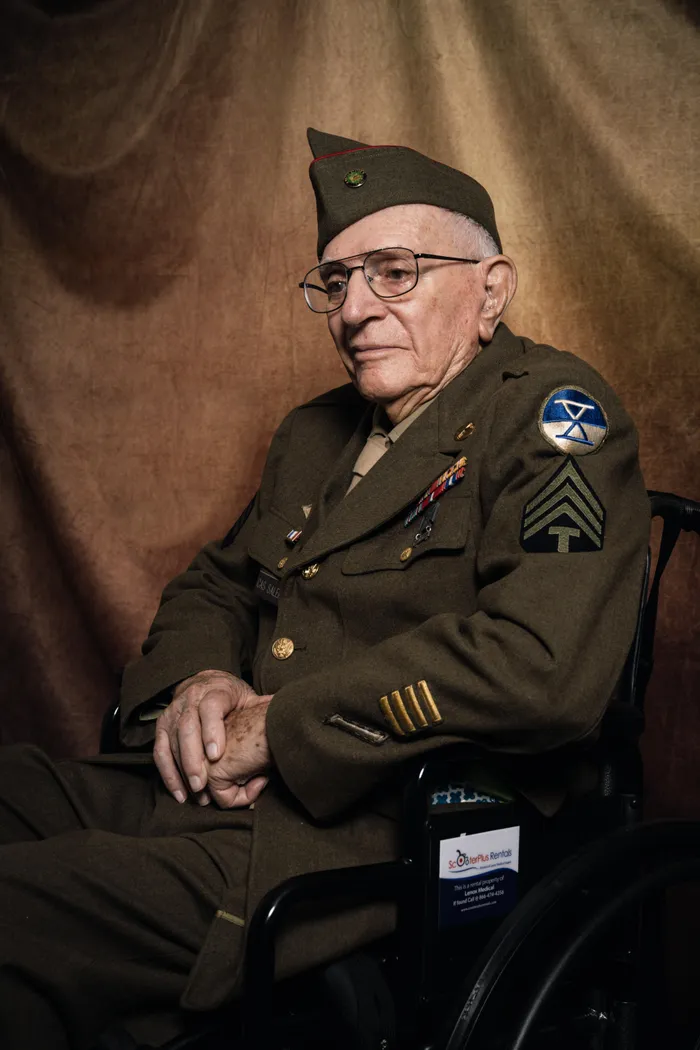
Caster Salemi, 103, tried to enlist in the Navy but was denied because he was color blind. He was later drafted by the Army.
Image: Maxine Wallace/The Washington Post
Caster Salemi, 103, Army
Caster Salemi, 103, of North Attleboro, Massachusetts, remembers being excited when he was drafted in 1943. The New York native was 21 and had tried to enlist earlier in the Navy but was told he was color blind. “We were fighting for all the groups that were affected by the Japanese bombing at Pearl Harbor and we always wanted to get some retribution,” Salemi said in an interview Saturday.
After a year of basic training in the Army he was sent to New Guinea and within days of arriving he saw his first combat. “It was a tank battle,” said Salemi, who served in the 25th Infantry Division. “I remember laying in a foxhole and it was raining. And I was saying to myself, ‘What am I doing here?’... I hadn’t realized how scary it would be.”
It would be the first of many combat experiences for Salemi. At the Balete Pass in the Philippines in 1945, Salemi and his unit were pinned down one day by Japanese fire and unable to respond. They would finally find cover but the battle would go on for three months before the Americans took control of the Balete area at the end of May. Salemi’s division lost nearly 700 men and another 2,100 were wounded. In a photo he sent home to his family, Salemi and another GI posed holding a Japanese flag captured at the end of the battle.
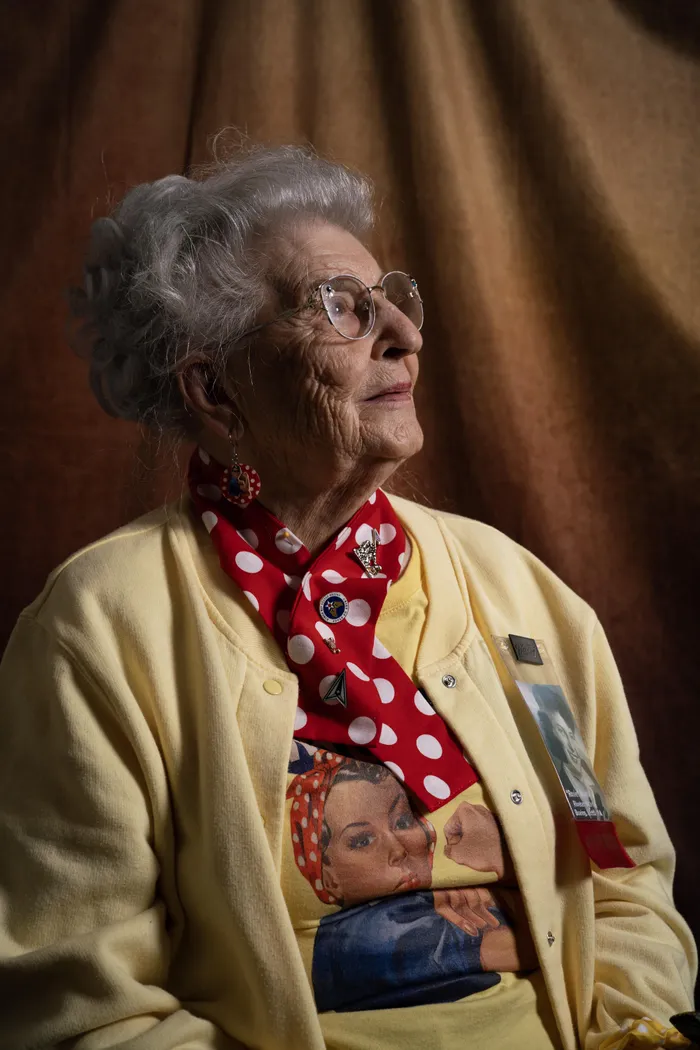
Mae Krier, 99, will turn 100 on March 21, which is also national Rosie the Riveter Day.
Image: Maxine Wallace/The Washington Post
Mae Krier, 99, Riveter
Mae Krier will turn 100 on March 21. That’s also National Rosie the Riveter Day, the country’s acknowledgment of the more than 6 million women like Krier who contributed to the war effort by filling jobs previously held by men who had left for Europe and the Pacific. In factories and plants across the country, the women built bombers and tanks, produced munitions and supplies and kept the home front humming.
Krier was 17 in 1943 when she left her small North Dakota town with her sister and took a job at Boeing in Seattle, building B-17 Flying Fortresses and B-29 bombers. The work she and the other women were doing, Krier said, sent a message to Germany.
“Hitler said he wouldn’t have any trouble defeating America because American women couldn’t produce. He said they were soft and spoiled and spend too much time on cosmetics and stockings,” Krier said. “I loved that, because we showed him what American women are made of.” She chuckled at the memory.
Krier, who lives in Levittown, Pennsylvania, has been a driving force to get recognition for all of the women like her who helped secure the Allied victory. More than 40 years ago she began writing to newspapers, companies and members of Congress, most of whom never responded. “When I first started I had no idea where it was going, but I just thought the women deserved recognition. And I never let up,” she said.
Last year Krier, joined by about 30 other Rosies, accepted the Congressional Gold Medal on their behalf at a ceremony in the U.S. Capitol.

Pilot Joe Peterburs, 100, flew 49 missions in a P-51 during World War II, also serving in the Korean and Vietnam wars.
Image: Maxine Wallace/The Washington Post
Joe Peterburs, 100, Army Air Forces
As a P-51 fighter pilot with the Army Air Forces, Joe Peterburs flew 49 combat missions in World War II. He had just strafed a German air base in 1945 when his plane was hit by enemy fire. Peterburs, who was 19, managed to bail out at 400 feet and hit the ground hard. The Minnesota native was captured by German troops and imprisoned but soon escaped.
“It was a war between good and evil,” Peterburs, who turns 101 later this month, said Saturday surrounded by family members, including two great-grandaughters. “Until mankind figures out a way to abide by the Golden Rule, ‘Do unto others as you would have them do unto you,’ we’re going to be in this sort of situation.”
Peterburs, who now lives near Sacramento, is also a decorated veteran of the Korean and Vietnam wars. Asked about the division today in the America he fought for, Peterburs was contemplative. The country, he said, is in “the pendulum stage.”
“I don’t know which way the pendulum is going to go but there’s nothing I can do about it anymore,” he said. “It’s the young people who are going to have to cope with it. And they may have to learn by some really, really bad experiences to find their way to a ‘life, liberty and pursuit of happiness’ type of life.”